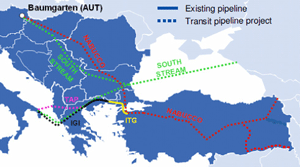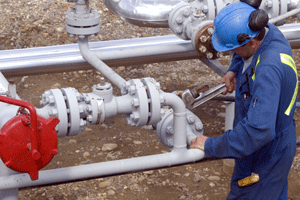'For Nabucco it is now or never'
on
‘For Nabucco it is now or never’
Will Europe be able to source gas from the Caspian region and the Middle East, bypassing Russia? That is the question on everybody’s mind in the European gas market, as the battle between the Russian-backed pipeline project South Stream and the EU-backed Nabucco project is coming to a head. (See the box below.) Brussels, Berlin and Washington are pushing hard for Nabucco, but it is the supply countries – Azerbaijan and Turkmenistan in particular – that will ultimately determine the fate of Europe’s great non-Russian gas pipeline. ‘The supply countries will need to make some key decisions in the coming months’, says Jeremy Ellis, Head of Business Development of RWE Trading in an interview with EER. ‘If the political will is there, Nabucco will get built. If not, the window of opportunity for Nabucco will be lost for a long, long time.’
 |
| Jeremy Ellis, Head of Business Development of RWE Trading |
Hidden in an unpretentious street in the mid-sized town of Essen, in the German Ruhr Area, lie the headquarters of RWE Supply and Trading, one of Europe’s largest energy trading companies. Most people passing by on the street, would no doubt be surprised if they were told that these offices harbour the biggest commodity trading room in Europe.
One of the tasks of the 250 staff who work on the trading floor of 3,000 square metres, is to manage the huge amounts of gas that RWE needs for its operations and customers: some 50 billion cubic metres (bcm) per year, about 10% of total European gas consumption.
RWE’s big appetite for gas is the reason why the company decided, in February 2008, to join the consortium of Nabucco, the gas pipeline that is intended to bring gas from the Caspian region and the Middle East to the Baumgarten hub in Austria, from whence it can be transported to the end users – for example, industrial companies in the Ruhr Area.
For RWE, Nabucco, which was started in 2002, is attractive because it can help diversify the company’s supply sources. For the EU as a whole, the project is important for the same reason. Gas consumption in the EU is expected to grow from 530 bcm per year now to 600-650 bcm in 2020. Imports are expected to grow from 300 bcm to 400-450 bcm. With domestic production on the decline, the EU is likely to become more heavily dependent on Russia. Against this background, Brussels has launched the concept of the “Southern Energy Corridor”, essentially an alternative route, through Turkey, to bring gas directly from the Caspian region and the Middle East to Europe without involving Russia. Nabucco is the lynchpin of this Southern Corridor, whose aim is to enhance security of supply and boost competition by diversification.
No one doubts that the Caspian Sea region (Azerbaijan, Turkmenistan and Kazachstan) and the Middle East (Iraq and Iran) have enough gas reserves to make up for Europe’s expected “shortfall”. The question is, are they willing to supply the gas to Europe – and to Nabucco? Jeremy Ellis, Head of
| Nabucco is not a do or die project for RWE. We have many opportunities available to us and a limited amount of capital. So it all comes down to the terms and conditions of supply that we can get |
How important is Nabucco for RWE?
We joined the consortium because it clearly offers us diversification to our supply portfolio. But Nabucco is not a do or die project for RWE. It is an enormous investment for any organisation to make. We have many opportunities available to us and a limited amount of capital. So it all comes down to the terms and conditions of supply that we can get. But we are fully committed to see Nabucco through. It assists us in our diversification perspectives, in developing upstream activities in certain regions, in our drive for further development in Turkey and Southern Europe and elsewhere.
Has there been political pressure on RWE to join Nabucco?
No, absolutely not. The project makes strategical, commercial and technical sense on its own merits.
Why is Nabucco important to Europe, in your view?
Europe is one of the world’s largest demand centres for gas. The Caspian and the Middle East make up the largest gas reserve region in the world. Today, there is no direct link between these two important demand and supply markets. To link those two markets through the Southern Corridor, i.e. Turkey and the south of Europe, is the logical thing to do.
By the construction of a pipeline, you create diversification and supply security for Europe. As you know, Europe is striving for further diversification and increased security of supply and rightly so, as some of the supply crises of the past few years have demonstrated. As a knock-on effect, you create more competition and additional investments in the south of Europe and Turkey.
Now the same advantages also apply for the supply side. Take the Caspian region. Those countries are looking to diversify their markets. Turkmenistan for example, which has traditionally been
| If you look at the challenge how to create additional security of supply to keep the heating on in winter in Europe and avoid gas crises, TAP and IGI do not qualify at all |
If it make such obvious sense to link these markets, why is it taking so long to make it happen?
Politics. Without politics, Nabucco would have been built many years ago. Technically, strategically, commercially, it is the right thing to do and it could have been realised significantly earlier. The dynamics of the process are closely tied up with the politics – with the various interests of the countries involved.
Does that mean the EU did not play it right, since there is still no final decision on Nabucco?
Today the political support is fully there. From the Commission, from Mr. Barroso, from Energy Commissioner Oettinger. That is shown by the actions the Commission has taken recently, in particular since Mr Oettinger has come on board. In addition we have the full support of the German government. In the coalition agreement of the new Merkel government that was signed in September, Nabucco is mentioned as a priority policy objective to diversify energy supplies. Chancellor Merkel has met President Aliyev (of Azerbaijan; EER). The US is fully supportive as well.
Turkey has proven to everyone that they are fully committed to Nabucco and to the Southern Corridor. They gain the same benefits as Europe.
The whole transit issue has been solved with the Intergovernmental Agreement (IGA) between the Nabucco transit countries. There are no outstanding disputes. So today we have complete alignment politically, commercially and technically on the midstream (transit) and downstream. The only remaining issue is the decision of the supply countries.
What about the competing projects IGI (Italy-Greece Interconnection) and TAP (Transadriatic Pipeline). They aim at the same supply sources (see box below).
IGI and TAP are technically and commercially far behind Nabucco. They do not have any transit rights through Turkey. They have opted to make a deal with Botas (the Turkish gas company) to use the existing transportation system, which is insufficient in its current state and needs to be upgraded to take such additional volumes of gas. This will create a higher risk profile for these projects. They also need access to the Greek and the Albanian transportation system. Another risk. So, TAP and IGI are jigsaws, whereas Nabucco is a clear picture.
They are complaining that they don’t get the political support Nabucco is getting. They feel there is no equal playing field.
 |
| The four Southern Corridor gas pipeline projects compared. Click for larger image |
Both TAP and IGI argue that Nabucco is unviable for the moment because supply is lacking for such a big pipe. Since they are smaller pipelines, they need less supply and can be built now, more or less as preparations for Nabucco, which can then be built at a later stage. Is that a possibility?
It doesn’t work that way. Without the supply no one will build a pipeline. Today, there is a window of opportunity to get Nabucco to the starting line. If that opportunity is lost, the political dynamics you need to get there will be lost for a long, long time. Russia knows that and so does Europe, Turkey and the supply countries. So, it is not a question of TAP and IGI getting here first and Nabucco second. It is a question of them first and nothing after. It is now or never for Nabucco.
If TAP or IGI were supplied out of Shah Deniz 2 (the big new gas field that is being developed now in Azerbaijan), would that be such a problem for Nabucco?
Nabucco is a multi-sourcing project. Azerbaijan, Northern Iraq and Turkmenistan constitute the supply picture. Azerbaijan is the key priority gas supply source to the Southern Corridor to start with. If the gas from Shah Deniz 2 will be allocated fully to other projects and not to Nabucco, Nabucco will not get built. As a consequence, there will be no diversification in South East Europe and Europe as a whole, nor in Turkey. So there is no other choice than Nabucco and again, it is now or never.
Now as far as TAP and IGI are concerned, you can also look the other way around. Nabucco cannot be realised through IGI or TAP, but IGI or TAP could be realised through Nabucco. That would be a win-win for everyone. And I mean either IGI or TAP. There is no point in building both of them. Either of these two projects could ship their gas through the Nabucco system. We have suggested to Edison and DEPA
| TAP’s and IGI’s main market is Italy, where prices may be slightly at a premium, but this is because it is not a fully transparent market |
But many people say that the Nabucco project, with 31 bcm, is too big for the moment and is not commercially viable, at least not in the near future.
That is rubbish. First of all, in Shah Deniz 2 there is 10-16 bcm available for Europe. In addition, in our estimates, Turkmenistan has 10-20 bcm available for buying at their western borders and Northern Iraq could supply another 10 to 20 bcm. That’s in line with the estimates of the Kurdistan Regional Government (KRG) in Northern Iraq. These are commercially and technically available gas supplies now or within the time frame Nabucco can start. So more than 31 bcm is there. Secondly, we will not need 31 bcm in full in order to get started.
Thirdly, there are of course the political dynamics. If these countries want to supply and get access to the European market, they now have a chance. Nabucco is only 31 bcm, it is not the end of the world, but it is a start.
How much do you need then to make the final decision to invest? We hear the banks say 8 bcm is a necessary starting point.
I rather do not want to be pinned down on a number because that may keep coming back to me. How much do we need? Ultimately it will be higher than 8 bcm and significantly less than 31 bcm. There are discussions with suppliers in three big cities at the moment – Baku, Arbil and Ashgabat. The Turkmens are running the risk of missing the boat if they don’t turn commitments into concrete terms. But Nabucco will be built as a multi-source project. That is fundamental.
If Nabucco is to be a multi-source pipe line, and if Turkmenistan does not come through, you only have two options left, Azerbaijan and Iraq. You seem to be skating on pretty thin ice then.
We are progressing on Azerbaijan, we are progressing on Northern Iraq and we are trying to progress on Turkmenistan. All those producers have the opportunity to join in. If Azerbaijan and Northern Iraq come together for the purposes of supplying Nabucco, then Turkmenistan is at risk of missing out for the first phase of Nabucco. It is now up to the Iraqi’s, Azeri’s and Turkmens to decide.
It has been argued by some analysts that Nabucco should have involved SOCAR (the state oil and gas company of Azerbaijan) as a shareholder. Why hasn’t this been done?
It certainly makes sense for SOCAR to take a share in Nabucco. Have they had the opportunity? There is always an open door for SOCAR.
How likely is that you will succeed with Iraq? There are big differences to be solved between the Kurdistan Regional Government (KRG) and the government in Bagdad. Not to mention the security situation.
They have the reserves, in the north, that is not an issue, and they can be securely transported. The KRG says they could supply up to 20 bcm per year. We are helping them with the technical know-how for infrastructure, to assist them in domestic gas growth and with gas exports. But please note there are no binding agreements in place – the discussions are investigating future cooperations. All stakeholders will need to align on gas supplies to Europe from Iraq.. But we firmly believe that linking Iraq to Europe and Turkey via Nabucco can be of benefit to Iraq and the Iraqi people.
What about your big competitor, South Stream?
All I want to say about South Stream, is this: if you were a supplier or shipper, and you had the choice, you would recognize that South Stream is three or four times as expensive as Nabucco, based on figures in the public domain. Clearly this will affect the price you can make. The choice seems pretty obvious to me.
So where does this leave Nabucco at this stage?
We are now at a very pivotal point on Nabucco, which is a good thing. When we joined, 18 months ago, it was all about transit. Now it’s about supply. The political will and support is certainly there in Brussels, in Berlin, in Washington. The decisions now have to come from the capitals and the countries where the supply has to come from. For us it is completely clear that Nabucco is the most economic way and from a technical point of view the most secure transit route to get these gas supplies to the European market. So for Nabucco it is now or never.
|
Battle of the pipelines
So what is it about? Nabucco, a project of RWE (Germany), OMV (Austria), MOL (Hungary), Botas (Turkey), Bulgargaz (Bulgaria) and Transgaz (Romania), and backed by the European Commission, the German and US governments, is meant to carry some 31 bcm of gas from the Caspian region and the Middle East through Turkey to Europe. The final investment decision is expected to take place in 2011, the start of the building in 2012 and the start of opertaions in 2015, depending on the timing of supplies. South Stream, a project of Gazprom (Russia), ENI (Italy) and prospectively EdF (France), is mean to carry 63 bcm of Russian gas to Europe. Can both these projects be built? Possibly, but not very likely. The expected demand shortfall in Europe is, according to the European Commission, 50 to 109 bcm by 2020. Given that new supplies are coming from LNG, North Africa and possibly unconventional gas, the building of both pipelines would likely lead to overcapacity. Most independent observers agree that Russia launched South Stream to prevent Nabucco from getting built. It is a matter of a dominant supplier trying to protect its market from new competition. For Europe it makes a difference, though, where new gas supplies will come from. South Stream will be supplied by Russia, and will increase dependence on that country. Supplies for Nabucco are expected to come from Azerbaijan first of all, and possibly Turkmenistan and Iraq. Hence the European Commission’s support for Nabucco. But there are other projects waiting in the wings. There is IGI, which bills itself as the ‘new route linking Europe with Caspian and Middle East Gas Reserves’. IGI, owned by a joint-venture Edison of Italy and DEPA of Greece called Poseidon, aims to carry 8 bcm of gas through an offshore pipeline across the Adriatic to Italy. The IGI is supposed to link up with a planned Turkey-Greece pipeline, a joint-venture of Botas of Turkey and DEPA. (The combined project is sometimes called the ITGI or Interconnector Turkey-Greece-Italy.) IGI or ITGI is battling it out with yet another project, the TAP (Trans-Adriatic Pipeline), which also claims to be ‘opening up the southern gas corridor’ to Europe, i.e. to carry gas from the Caspian and Middle East to Europe, some 10 bcm, via Turkey, Greece and Albania through the Adriatic to Italy. TAP is owned by an interesting line-up of partners: EGL of Switzerland, Statoil of Norway and Eon Ruhrgas of Germany. Analysts agree that IGI and TAP cannot both be built – this would lead to large overcapacity in the Italian market. What is problematic for Nabucco is that these projects aim at the same supply sources – in particular Azerbaijan, Turkmenistan and Iraq. This means that if either of these projects were to get built, there would not be enough supply to justify Nabucco. One possibility is for Nabucco to merge or “converge” somehow with either IGI or TAP, but that is only likely to happen if the partners in IGI or TAP were to abandon their own project and join Nabucco. Vice versa would not be possible. And there are still other projects being discussed, such as the Azerbaijan–Georgia–Romania Interconnector (AGRI) and White Stream, but they look to be outside chances at the moment. |



Discussion (0 comments)